The Social Security Administration (SSA) confirmed the benefit distribution schedule for May 2025. Payments will be allocated based on beneficiaries’ dates of birth, divided into three consecutive Wednesdays. This structure aims to optimize fund management and avoid congestion in transfer systems.
The first group, born between the 1st and 10th of any month, received their payments on the second Wednesday of the month, which was May 14. Then, those Americans and citizens born between the 11th and 20th saw the money hit their accounts on Wednesday, May 21, which was the third of the month.
The last of these groups are those born between the 21st and 31st, who will access their funds on May 28.
A group receives their Social Security payments on the same day every month
There is one exception for a group of beneficiaries who began receiving benefits before May 1997: their benefits always arrive on the third day of the month. The next payment for these beneficiaries will be on June 3rd, a date also shared by those who receive Social Security retirement in combination with Supplemental Security Income (SSI arrives on the first day of the month and retirement on the 3rd).
But there’s an important clarification for this last group: In June, June 1st falls on a Saturday, so SSI payments will be moved up to May 30th. The rest of the dates will remain unchanged.
There is a risk that Social Security benefits will be cut
The Congressional Budget Office (CBO) proposed replacing the current Social Security system with fixed payments of $1,660 for individuals and $2,250 for couples. The measure seeks to stabilize the program’s finances but would reduce benefits for an estimated 75% of beneficiaries.
Although the plan would generate savings of $607 billion over a decade, it would not resolve the projected $22.6 trillion deficit. Other options under discussion include adjusting inflation rates, raising the retirement age, or raising taxes, but none comprehensively address the financial problem.
The proposal has sparked debate over its impact on low-income retirees. While some experts highlight its simplicity, others warn of the risks for those who rely on cost-of-living adjustments. The political viability of the plan remains uncertain, with no concrete legislative progress so far.
Cuts over the SSA affects benefits and services
The SSA plans to cut approximately 7,000 jobs, or 12% of its workforce, by 2025. The move comes in response to tight budgets, but has raised concerns about delays in essential services, such as claims processing and customer service.
Local offices report losses of up to 58% of their staff, according to internal data. This has increased wait times for telephone or in-person consultations, affecting millions of beneficiaries who require immediate assistance.
Public administration experts warn that the cuts could impair the SSA’s operational capacity in the medium term. The reliance on automated systems and digital channels has not offset the reduction in staff, especially in areas with low connectivity or an aging population.
